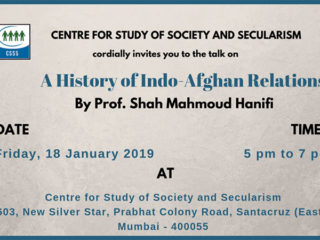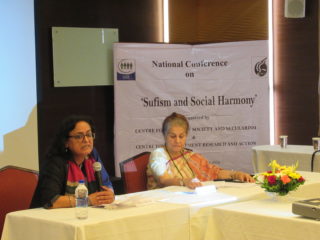Date: 29th October 2016, Time 4. p.m. Venue: CSSS office, Mumbai
By Report Sai Bourothu
Mr. Bashir Manzar, Editor of the Kashmir daily Kashmir Images, condemned the Indian Government for betraying the trust and goodwill of the Kashmiri population and the use of brutal authoritarian force to thwart peaceful democratic dissent in the valley. Mr. Manzar spoke on the “Current Situation in Kashmir” in a study circle event organised by Centre for Study of Society and Secularism.
The politics of Kashmir cannot be looked at in isolation from that of Jammu and Ladakh. Jammu is a predominantly Hindu region, Kashmir is predominantly Muslim and Ladakh is home to a majority Buddhist population. With different demographics and political situations, the aspirations and needs of all three regions are also diverse and often contradictory to each other.
Though the current political unrest in the valley is seen as a reaction to the killing of Burhan Wani, a militant of Hizbul Mujahedeen, it would be oversimplifying the distress of Kashmiris. Kashmir is reacting to communal politics of right wing Hindutva forces, be it the controversy over beef, ghar wapsi or love jihad which have instilled a fear and insecurity across the country. The valley never faced any instances of tensions over these issues, but recently, a Kashmiri truck driver in Udhampur was murdered by cow vigilantes for allegedly transporting cows for slaughter.
The elections of 2014 unified the valley to give a mandate to PDP which fought the election under the slogan of keeping the BJP out of Kashmir. However, the coalition that formed after the elections in the form of the PDP-BJP alliance that presently holds power in Kashmir led to great dissatisfaction in the valley. At present, the most affected areas of the valley are from South Kashmir, which gave an unanimous mandate to PDP, and hence feels most betrayed. This alliance of convenience did not fool anyone as the BJP had been strongly campaigning for the removal of Article 370 in mainland India, while simultaneously joining hand with PDP that stood solidly for the Article to remain. The agenda of alliance that was drafted by the two parties tried to resolve the differences by majorly two points:
- There will be no debate or discussion on section 370.
- Laws applicable in the valley such as the Armed Forces Special Provisions Act (AFSPA), Public Safety Act will be reconsidered.
The pro-active targeting of Kashmiri sentiments in the form of anti-Article 370 campaigns, proposed plans for Sainik colonies and separate colonies for Kashmiri pandits has simmered to reach this point of outburst. Apart from the fact that Kashmir valley has been highly militarised, the proposed Sainik colonies seem to be an indirect way of attacking Article 370. The attempts to rehabilitate Kashmiri pandits are also targeted towards a form of segregation which will never be able to mitigate communal tensions but instead add fuel to it. The use of pellet guns to counter “violence” caused by Kashmiri stone pelting can never justify 95 deaths and more than 3000 people injured. Mr. Manzar also pointed to the violence that was resulted by the Jat and Patel agitations. Despite massive loss of property and violent crimes of sexual assault against women, we did not see the use of pellet guns by the government to maintain law and order. The use of brutal force to suppress agitations in Kashmir is not solely an issue of maintaining law and order but is aimed at instilling the feeling of subjugation within the valley. Another distressing situation is the attitude of the Government of India which holds no regret for the plight of Kashmiris that they have caused.
The attitude of the Government of India towards the Kashmiri people also becomes evident with an example of 2010, which saw the killing of four innocent Kashmiris by the armed forces on allegations of being terrorists followed by a series of protests, rallies and gathering condemning the murders. The violence that pursued saw the death of almost 123 people by the close of it. As a response to this, the Government of India appointed a committee under the Ministry of Home Affairs headed by Mr. P Chidambaram. After an expansive study of the region for two years which covered various cross sections of people, a report was submitted. The report was however, shelfed and forgotten. This is the attitude and extent of willingness the GOI is ready to commit to peace in the valley. There were many committees that were assigned similar tasks in the years to come, but ended in the same fate as its predecessors. Moreover, the only time GOI responds to the plight of Kashmir in the otherwise numbing silence around the issue is when Kashmir erupts in protests and violence.
While on one hand Kashmir faces the brunt of Indian Government’s brute force and apathy, the Hurriyat leaders of Kashmir have crippled the economy of the valley completely. The weekly calendars of strikes and bandhs that have been announced have halted the valley for four months till now. Schools, trade and local businesses, transport etc. have been come to a still. With winter knocking at the door and the examinations for schools just across the corner, the situation in Kashmir seems bleak for the coming months as well. The valley has been paralyzed through coercion by Hurriyat and the Government of India in an orchestrated and meticulously planned manner, leaving Kashmiris helpless and unable to cope.
The portrayal of Kashmir in mainstream Indian journalism is disturbing and enraging. The lived experience of being a Kashmiri is being appropriated continuously while the voices of Kashmir are being stifled by local leadership and the GOI. There are also widespread notions of the Azadi movement being orchestrated by Pakistan, but I would strongly disagree with the same. The Azadi movement dates back to pre-independence. The Azadi sentiments existed while the popular leadership in Kashmir led by Mr. Shaikh Abdullah decided to recede to India, the Azadi sentiments existed while the same popular leadership which offered Kashmir to India on a silver platter was jailed for 14 years, and the Azadi sentiments exists now when the unarmed citizens of Kashmir are meted with pellet guns in return for stones. Oversimplifying the Azadi struggle is a propaganda which should be tackled and challenged with facts. Both India and Pakistan have contributed to the best of their abilities to maintain uncertainty, violence and bloodshed in the valley.
While the apathy of the Indian government stays resolute on destroying the valley with unlikely allies in the cause from the Hurriyat leadership, there is a possibility that the population of Kashmir is counter-radicalizing. With no efforts from the Indian Government to engage with the youth and common citizens of Kashmir, I fear what this radicalization might lead to, Mr. Manzar concluded.



